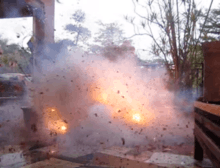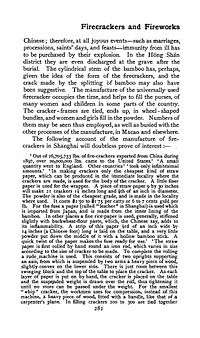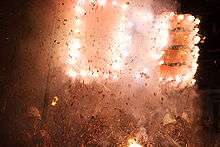Firecracker

A firecracker (cracker, noise maker, banger, or bunger[1]) is a small explosive device primarily designed to produce a large amount of noise, especially in the form of a loud bang; any visual effect is incidental to this goal. They have fuses, and are wrapped in a heavy paper casing to contain the explosive compound. Firecrackers, along with fireworks, originated in China.
History

The predecessor of the firecracker was a type of heated bamboo, used as early as 200 BC, that exploded when heated continuously. The Chinese name for firecrackers, baozhu, literally means "exploding bamboo."[3] After the invention of gunpowder, gunpowder firecrackers had a shape that resembled bamboo and produced a similar sound, so the name "exploding bamboo" was retained.[4] In traditional Chinese culture, firecrackers were used to scare off evil spirits.[4]
Contents of firecrackers
Firecrackers are generally made of cardboard or plastic, with flash powder, cordite, smokeless powder, or black powder as the propellant. This is not always the case, however. Anything from match heads, kerosene to lighter fluid have been used successfully in making firecrackers. The key to loud firecrackers, however, although in part lying in the propellant substance, is pressure. The entire firecracker must be very tightly packed in order for it to work best. Flash powder, however, does not need to be packed tightly, and should not be.
How firecrackers were made

James Dyer Ball, in his book Things Chinese, has a detailed description about the process and material used for making firecrackers at the end of the 19th century. At that time, firecrackers were made by female and child workers, using straw paper to make the body of the firecracker, while the fuse was made of bamboo paper imported from Japan, then stiffened with buckwheat paste. The bamboo paper was cut into strips of 14 inches (360 mm) long and 1⁄3 inch (8.5 mm) wide, laid on a table; a string of gunpowder was placed at the center with a hollow tube, then twisted up to make a piece of fuse. The firecracker tubes were made from pieces of straw paper wrapped around iron rods of various diameters and then tightened with a special tool. 200 to 300 firecrackers were tied up in a bunch, then red clay was spread at the bottom of the bunch and forced into each end of the firecracker with a punch; gunpowder was poured in, then the other end was sealed with an awl by turning the tube inward, and a fuse inserted.[5]
Culture

Firecrackers are commonly used in celebration of holidays or festivals, such as Halloween, Independence Day (also known as the Fourth of July) in the United States, Diwali in India, Eid al-Fitr in Southeast Asia, Tihar in Nepal, Day of Ashura in Morocco, Guy Fawkes Night or Bonfire Night in the United Kingdom, Halloween in Ireland, Bastille Day in France, Spanish Fallas, in almost every cultural festival of Sri Lanka (e.g. Sri Lankan New Year), New Year's Eve and New Year's Day, Purim in Israel, and in the celebration of Chinese New Year by Chinese communities around the world.
In Wales the slang term for a firecracker, typically used on Guy Fawkes Night, is a "jacky-jumper".[6]
Legality of firecrackers
Firecrackers, as well as other types of explosives, are subject to various laws in many countries, although firecrackers themselves are not usually considered illegal contraband material. It is usually the manufacture, sale, storage, and use of firecrackers that are subject to laws including safety requirements for manufacture, the requirement of a permit to sell or store, or restrictions on the use of firecrackers.
Firecracker ban
The use of firecrackers, although a traditional part of celebration, has over the years led to many injuries and deaths. There have been incidents every year of users being blinded, losing body parts, or suffering other injuries, especially during festivities that customarily involve firecrackers such as Chinese New Year season. Hence, many governments and authorities have enacted laws completely banning the sale or use of firecrackers, or banning the use of firecrackers in the street, primarily because of safety or environmental reasons. These rules also require a permit from the local government, as well as any relevant local bodies such as maritime or aviation authorities (as relevant to the types of fireworks being used) and hospitals, schools, etc. within a certain range.
- Canada — Firecrackers are not authorized under the Explosives Act, thus making importation, possession, transportation, storage, or manufacturing illegal in Canada.[7] Canada banned firecrackers on September 27, 1972 after media reports that two children were killed and three others severely burned when some older children were playing with firecrackers outside their tent. It later came out that the children inside the tent had actually been smoking and, not wanting to tell their parents, had told them they had been playing with firecrackers.[8] Fireworks are still legal to buy for anyone 18 years of age or over.
- Mainland China — As of 2008, most urban areas in mainland China permit firecrackers. In the first three days of the traditional New Year, it is a tradition that people compete with each other by playing with firecrackers. However, many urban areas banned them in the 1990s. For example, they were banned in Beijing's urban districts from 1993 to 2005.[9] In 2004, 37 people were killed in a stampede when four million[10] people gathered for a rumored Lantern Festival firework display in nearby Miyun.[11] Since the ban was lifted, the firecracker barrage has been tremendous. An unusual feature is that many residents in major cities look down on street-level fireworks from their tower blocks. Bans are rare in rural areas.
- Czech Republic — Firecrackers are legal in the Czech Republic.
- Germany - Fireworks are classified. Some fireworks are restricted to adults (18 years), may be sold to private persons only on three days before Silvester and may be used only on Silvester or New Year (special permits can be obtained to use these on other days of the year). Other fireworks have no such restrictions, however, they are not recommended for children below 12 years and guidance by adults is advised. Certain fireworks are available only to professionals.
- Hong Kong — Fireworks are banned for security reasons, as some speculate a connection between firework use and the 1967 Leftist Riot. However, the government stages a fireworks display in Victoria Harbour for New Year countdown and the second day of the Chinese New Year.
- Hungary — Firecrackers are banned in Hungary since 2005. However, they are legal in Slovakia and people smuggle them.
- Indonesia — Firecrackers and fireworks are generally forbidden in public during the Chinese New Year, especially in areas with significant non-Chinese populations, to avoid conflict between the two. However, there are some exceptions. The usage of firecrackers is legal in some metropolitan areas such as Jakarta and Medan, where the degree of racial and cultural tolerance is higher.
- Italy — Firecrackers are legal and can be bought without a licence by anyone 18 years of age or over.

- India — Firecrackers are easily available in India. Firecrackers are used in the Indian festival of light(Diwali), and also for marriage ceremonies. Sivakasi a city located in South India supply Firecrackers to all over India.
- Malaysia — Firecrackers are banned for similar reasons as in Singapore. However, many Malaysians smuggle them from Thailand and the Philippines.
- Norway — The government of Norway decided to ban rockets in early 2009. Other types of fireworks are still allowed.
- Philippines — Fireworks and firecrackers are widely available throughout the Philippines and Republic Act 7183 was enacted to regulate and to control the sale, distribution, manufacture and use of firecrackers for public safety.[13] In the said law, there are certain firecrackers that are legal such as Judas' belt and the prohibition of a certain firecracker and pyrotechnic devices shall be determined by the Director-General of the Philippine National Police. Although, there are cities in the Philippines banning all kinds of firecrackers and those cities are Muntinlupa (since 2013), Olongapo (since 2008)[14] and Davao City (since 2001).[15][16] Injuries involving the use or ingestion of "Piccolo" sticks account for the majority of firecracker-related incidents in the country.[17][18]
- Republic of Ireland — Fireworks and firecrackers are not permitted in the Republic of Ireland; however, many people smuggle them from Northern Ireland, where they are legal. They are most common around Halloween.
- Singapore — A partial ban on firecrackers was imposed in March 1970 after a fire killed six people and injured 68.[19] This was extended to a total ban in August 1972, after an explosion that killed two people.[20] and an attack on two police officers attempting to stop a group from letting off firecrackers in February 1972.[21] However, in 2003, the government allowed firecrackers to be set off during the festive season. At the Chinese New Year light-up in Chinatown, at the stroke of midnight on the first day of the Lunar New Year, firecrackers are set off under controlled conditions by the Singapore Tourism Board. Other occasions where firecrackers are allowed to be set off are determined by the tourism board or other government organizations. However, their sale is not allowed.
- Sweden — Only rocket-type fireworks are allowed in Sweden. The ban of firecrackers was effectuated by the EU Parliament and Swedish government effective December 1, 2001, but in 2006 the EU Parliament changed the laws, allowing smaller types of firecrackers. By 2008, the law had to be in effect in all EU member countries, including Sweden.
- Taiwan — Beginning in 2008, firecrackers are banned in urban areas, but still allowed in rural areas.
- United Kingdom — In 1997, firecrackers became illegal, but most other consumer fireworks are legal.[22]
- United States — In 2007, New York City lifted its decade-old ban on firecrackers, allowing a display of 300,000 firecrackers to be set off in Chinatown's Chatham Square.[23] Under the supervision of the fire and police departments, Los Angeles regularly lights firecrackers every New Year's Eve, mostly at temples and the shrines of benevolent associations. The San Francisco Chinese New Year Parade, the largest outside China, is accompanied by numerous firecrackers, both officially sanctioned and illicit.
- Vietnam — In 1994, the Government decided to ban firecrackers nationwide. Only fireworks displays produced and performed by the government are permitted.
Firecracker brands, packs and labels
Early (pre-1920s) Chinese firecrackers (also known as "Mandarin firecrackers") were typically 1⁄2 to 2 inches (13 to 51 mm) long, and approximately 1⁄4 inch (6.4 mm) in diameter, and were charged with black powder. Mandarin crackers produced a less loud, duller thud compared to modern flash-light crackers (which utilize a different explosive known as flash powder). Mandarin crackers produced a dimmer, less brilliant flash when they exploded also. Individual Mandarin crackers were most often braided into "strings" of varying lengths, which, when ignited, exploded in rapid sequence. Generally, the strings (sometimes containing as many as several thousand crackers) would be hung from an overhead line before ignition. Most Mandarin crackers were colored all red and did not generally have designs or logos decorating their exterior surface (or "shell wraps"). Occasionally a few yellow and green Mandarin crackers were created and would be braided into the predominantly all-red strings to symbolize the emperor and the ruling class, while the numerous red crackers symbolized the common man.

Once flash powder, which produces a significantly sharper and brighter bang, replaced black powder as a firecracker's explosive charge (circa 1924), manufacturers began competing to gain loyalty of typical consumers (that is, mainly boys eight to 16 years old). Thousands of brands were created during the flash-light cracker's heyday from the 1920s through the early 1970s. Only a small percentage of brands lasted more than a year or two. Collectors now seek the various labels from the era.[24]
Until the mid-1980s, firecracker production was low-tech. They were handmade, beginning with rolling tubes. Once the firecracker tubes were rolled by hand (commonly from newspaper) and labelled, and then filled with powder, their ends were crimped and fuses inserted, all by hand. These finished firecrackers were usually braided into "strings" and sold in packs which came in many sizes, from the very small ("penny packs" containing as few as four to six firecrackers) to the most common size packs (containing 16 and 20 crackers per pack), to larger packs (containing 24, 30, 32, 40, 50, 60, 72, 90, 100, and 120 firecrackers), to huge "belts" and "rolls" (packages containing strings of several hundred to several thousand crackers—Phantom Fireworks sells rolls as large as 16,000 firecrackers[25]). Firecracker packages were wrapped in colourful and translucent glassine paper, as well as clear cellophane, with glassine the most popular.
The final operation involved applying a branded label on each pack, then bundling finished packs into wholesale lots called "bricks" which contained an average of 80 packs each (varying according to the size of the packs being bundled; for example, packs of 32 crackers might have 40 packs per brick, compared to packs of 16 or 20 with 80 packs per brick).
See also
References
- ↑ Miller, John. The Essential Lingo Dictionary: of Australian words and phrases. Exisle Publishing. Retrieved May 29, 2017.
- ↑ Needham, Joseph (1987). Science & Civilisation in China, volume 7: The Gunpowder Epic. Cambridge University Press. p. 140. ISBN 0-521-30358-3.
- ↑ David Curtis Wright (29 September 2005). Thomas F. Glick; Steven J. Livesey; Faith Wallis, eds. Medieval Science, Technology, and Medicine: An Encyclopedia2. Psychology Press. p. 211. ISBN 978-0-415-96930-7.
- 1 2 Hugh Baker (1 June 2011). Ancestral Images: A Hong Kong Collection. Hong Kong University Press. p. 184. ISBN 978-988-8083-09-1.
- ↑ James Dyer Ball, Things Chinese, 4th edition, p195, NY 1906
- ↑ "jacky-jumper - Dictionary of Playground Slang (Online)". Odps.org. Retrieved 2015-11-07.
- ↑ "Authorization Guidelines for Consumer and Display Fireworks". Archived from the original on 2013-06-05.
- ↑ Firecracker fun a thing of the past
- ↑ People's Daily 'Beijing to loose 12-year ban on firecrackers', peopledaily.com, 20 July 2005, accessed 11 November 2008.
- ↑ This is the figure given by the China Daily, citing the official news agency Xinhua. However, some caution should be exercised over it: although a small proportion of Beijing's population, it is ten times the normal population of Miyun County. Mandarin handles large numbers differently from English, so translation errors are common.
- ↑ China Daily Rumors of fireworks display lead to stampede, chinadaily.com 11 February 2004, accessed 11 November 2008.
- ↑ "Til oil bath marks Chhoti Diwali celebrations". The Times of India. 3 November 2013.
- ↑ "REPUBLIC ACT NO. 7183". chanrobles.com. Retrieved December 28, 2016.
- ↑ "Ordinance 29 series of 2014 - General Santos City" (PDF). Retrieved 1 January 2016.
- ↑ Geronimo, Gian (1 January 2013). "Firecracker ban keeps Davao City injury-free for fourth straight year". GMA News. Retrieved 1 January 2016.
- ↑ Lacorte, Germelina. "Horns define Davao New Year". Philippine Daily Inquirer. Retrieved 1 January 2016.
- ↑ Uy, Jocelyn (8 December 2015). "DOH urges ban on ‘piccolo’ firecracker". Philippine Daily Inquirer. Retrieved 1 January 2016.
- ↑ "Piccolo still cause of most firecracker-related injuries —DOH". GMA News. 28 December 2015. Retrieved 1 January 2016.
- ↑ Book soul 1970, book-soul.com
- ↑ Chingay Past Archived August 3, 2006, at the Wayback Machine., chingay.org.sg
- ↑ Akbur M., Peer (2002). Policing Singapore in the 19th and 20th centuries. Singapore Police Force. p. 100. ISBN 981-04-7024-X.
- ↑ "BANGERS BANNED AND BOYS BEHAVING BADLY GIVEN A ROCKET IN FIREWORK CLAMPDOWN - October 14,1997 /PR Newswire UK/". Prnewswire.co.uk. Retrieved 2015-11-07.
- ↑ Can you pig it? New York goes hog-wild for Chinese New Year Archived February 19, 2007, at the Wayback Machine., New York Post, February 17, 2007.
- ↑ www.crackerpacks.com A Guide To Collecting Chinese Firecrackers
- ↑ Phantom Fireworks catalog page for 16,000 roll Retrieved 2010-12-31
External links
| Wikimedia Commons has media related to Firecracker. |
- www.crackerpacks.com guide to collecting firecrackers
- The late Dennis Manochio Senior world's largest 4th of July Americana and fireworks collector! Historian for the American Pyrotechnics Association
- Severe firecracker injury to the hand (Warning: graphic photo)